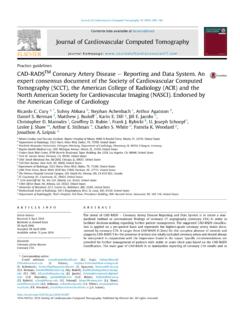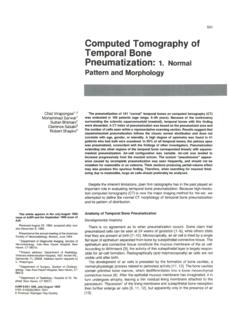Transcription of Computed Tomography: Annual Safety Training
1 _____ MPC TJC-CT Safety Ver 08/2015 1 Computed tomography : Annual Safety Training Name: Facility: Once you have reviewed the material referenced, initial the left hand column for each item. Further information on select items listed can be found at the web links below. Radiation dose optimization for adult and pediatric protocols, as addressed in Image Gently and Image Wisely campaigns Safe procedures for operation of CT equipment Expected or typical dose levels for common CT exams Dose notification and alert levels Adult CT scan protocols I have read the documents and understand their content. I have visited the linked websites and am familiar with the information available to myself and my patients referenced in these sites.
2 If I have any questions in the future regarding these matters, I realize that I may request additional information from my supervisor, the Radiation Safety Officer, or a physicist at Medical Physics Consultants, Inc. (734-662-3197). Signature: _____ Date:_____ _____ MPC TJC-CT Safety Ver 08/2015 2 Computed tomography : Annual Safety Training Radiation dose optimization: Patient radiation doses from CT scans can be much higher than those delivered in routine diagnostic radiology. Many organizations have taken on campaigns to optimize or minimize the radiation levels delivered from CT. Image Gently was created to help healthcare providers use lower radiographic techniques for pediatric patients, in part because adult techniques had been inappropriately used and because young patients are more sensitive to radiation effects.
3 This website has many resources, including vendor-specific modules, to help you modify your protocols to keep pediatric dose optimize. We recommend that you visit this site and Take the Pledge at: Image Wisely was created to help reduce radiation doses for adult patients. Their website has resources to guide protocol modification for dose optimization, vendor-specific information provided by CT manufacturers. Please visit to Take the Pledge at: Safe procedures for operation of CT equipment: As part of the effort to improve CT dose optimization, several organizations have developed CT scanner performance requirements. NEMA-MITA, has developed XR-29 Standard Attributes on CT Equipment Related to Dose Optimization and Management , also called Smart Dose.
4 There are 4 components to Smart Dose. 1. DICOM Radiation Dose Structured Report for post-exam electronic reporting of dose levels delivered from each exam. This can be included in the patient s record and compared to national benchmarks for comparison. 2. CT Dose Check incorporates the programmed dose notification and alert levels to caution the CT operator prior to scanning with an excessive technique that will exceed threshold levels. 3. Automatic Exposure Control allows the CT scanner to modulate the tube current (mA) to maintain optimum dose levels to the image detectors. It can be preset based on localization scans or on-the-fly variable modulation during scanning. 4. Pediatric and Adult Reference Protocols must be preloaded on the system. These protocols should be routinely reviewed to ensure they are still relevant and that dose levels are within guidelines.
5 _____ MPC TJC-CT Safety Ver 08/2015 3 Computed tomography : Annual Safety Training Expected or typical CT dose levels: Medical Physics Consultants, Inc. (MPC) has developed the following table of expected CTDIvol ranges, based on years of testing hundreds of CT scanners. Any CTDIvol values that are outside these ranges should be evaluated to determine if the exposure to the patient was appropriate. CT image quality generally improves as the CTDIvol increases. A CTDIvol below the minimum range could be an indication that patient dose was low enough to result in poor image quality. However, a low value could be acceptable if the patient was very small. A CTDIvol above the maximum could be an indication that the dose was higher than necessary to give good image quality.
6 However, a high value could be acceptable if the patient was very large. Use the attached Abnormal CTDIvol Tracking Log to meet The Joint Commission s requirement ( ) to record any CTDIvol values outside the expected ranges. If there are instances that cannot be adequately explained by patient size, work with your CT protocol committee to improve that particular protocol. Adult CT scan protocols: Several common adult CT exam protocols are listed on the American Association of Physicists in Medicine website. Vendor-specific recommendations for exam protocols and teaching presentations can be found at this link: CT Protocol Committee: The Joint Commission requires ( ) that CT imaging protocols be kept current with input from an interpreting physician, a medical physicist, and the lead CT technologist, who comprise the CT Protocol Committee.
7 After an initial thorough review, any proposed changes to the saved protocols need to be approved by the CT Protocol Committee. Ideally, the existing protocols will be password protected with a password known only to the lead CT technologist and the CT/radiology manager. None of this prevents a technologist from using his/her expertise to optimize the CT technique factors for an individual exam as may be necessary. LowNormalHighCTDIvol (mGy)CTDIvol (mGy)CTDIvol (mGy)Brain406080 Base of Head70100120 Brain Perfusion250500600 Spine103060 Chest81225 Low Dose Lung Screening135 Abdomen81850 Extremity4820 Extremity81640 Pediatric Head (< 10 years old)203050 Pediatric Abdomen (<10 yrs old)3815 Pediatric Abdomen (<10 yrs old)51225 Pediatric Chest (<10 years old)2510 Pediatric Chest (<10 years old)41020 Dose Notification (CTDIvol for a single series) Suggestion:Dose Alert (highest CTDIvol from the entire exam) Suggestion: Typical ranges for CTDIvol for common CT examsMichigan Rule (2) states "The CT operator shall check the display panel before and after performing each scan to make sure the amount of radiation delivered is appropriate for the technique and individual patient.
8 This may be accomplished by reviewing dose indicator devices if available or dose indices such as the technique factors. Dose indicators or indices outside of expected values shall be documented and reviewed by an interpreting physician or medical physicist."If more than 2% of your patients generate dose notifications, contact your physicist for advice regarding those specific not require a password to exceed the Dose Alert. Sinus, Facial Bones should be less than half of these values16 cm16 cm16 cm32 cm32 cm32 cm32 cmincludes: Hand, Elbow (above torso), Foot, Ankle, KneePhantom Size32 cm16 cmThese guidelines are for educational purposes only and should not be considered standards or : Abdomen, Pelvis, Renal Stones, Urogram, CarotidIf Dose Alert is set for the system as a whole, use 1000 cmSinus, Facial Bones should be less than half of these valuesincludes: Posterior Fossa, IACincludes: Cervical, Thoracic, Lumbar, Neck, Shoulder16 cm16 cm32 cm32 cmincludes: Chest, PE, AAAincludes: Ca Scoring, CTA _____ MPC TJC-CT Safety Ver 08/2015 4 Dose notification and alert levels: NEMA-MITA has developed XR-25 Dose Check Standard with 2 action levels regarding radiation doses from CT scans.
9 The Notification value is the projected level of radiation prior to each scan that might exceed the following thresholds established by the ACR/AAPM: Exam CTDIvol (mGy) Adult Head 80 Adult Torso 50 Brain Perfusion 600 Cardiac-retrospective 150 Cardiac-prospective 50 Pediatric Head (<2 year old) 50 Pediatric Head (2-5 year old) 60 Pediatric Torso 25 Notification values need to be programmed in as part of each scan s protocol. The nationally established Notification values are high and are almost never reached. Your MPC physicist can assist you in establishing Dose Notification values appropriate for your particular scanner s characteristics. The Alert value triggers an alert to the CT operator when the system projects that the combined planned scans in an exam will exceed the set threshold level.
10 Generally, one Alert level is established for all the protocols on a scanner. MPC does not recommend requiring a password to be entered when Alert levels are exceeded, but does require the operator to document the reason that the Alert value was exceeded. The standard can be found here: Site:Scanner:HeightWeightCTDIvolDLPA nalysis:Analysis:Analysis:Analysis:Analy sis:Analysis:Analysis:Analysis:Analysis: Analysis:Reviewer's InitialsAbnormal CTDIvol Tracking LogExam datePatient IDExam typePatient SizeDelivered DoseDate reportedDate reviewedCT Dose Log 08 17 15 (c) MPC










